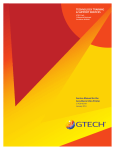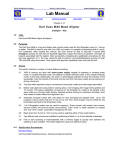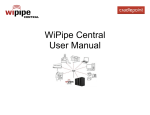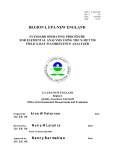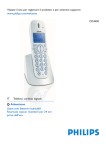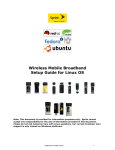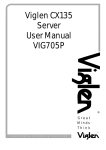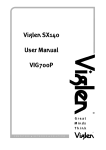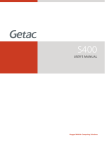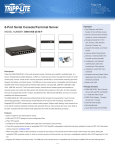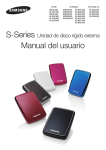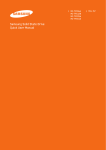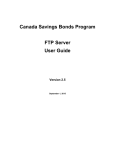Download Dual Comm Inside_2_CDC_003_01_2
Transcript
TECHNOLOGY TRAINING & SUPPORT SERVICES GTECH S.p.A. 10 Memorial Boulevard Providence, Rhode Island 02903 Service Manual for Dual Comm Inside 2-CDC-003-01 July 2014 Copyright Windows is a registered trademark of Microsoft Corporation in the United States and other countries. All other trademarks in this document are owned by or licensed to GTECH S.p.A. or Spielo International Canada ULC and are registered or pending registration in the United States and other countries. This document is the property of GTECH S.p.A., Providence, RI, and Spielo International Canada ULC. It contains confidential and trade secret information. This document, including all information within it, may not be used, transferred, reproduced, published, or disclosed, in whole or in part, directly or indirectly, except as expressly authorized by an officer of GTECH S.p.A. pursuant to written agreement. Copyright © 2014 GTECH S.p.A. and Spielo International Canada ULC. All rights reserved. Revision History This document describing Dual Comm Inside has a revision number. Each time this document is updated, the document revision number is updated. The number below represents the current revision of this manual. Service Manual for Dual Comm Inside 2-CDC-003-01 For future documentation revisions, the last two digits of the number above will increment by 1 (for example, when revision 01 is revised, the last two digits in the number above will become 02). Revision details are tracked in the table below. Revision # Description Date Writer 2-CDC-001-01 Release March 2011 S. Lataille 2-CDC-003-01 Service Manual Updates and Release July 2014 J. Pearson No provisions exist for automatic, on-site updates of this manual. RH-i This manual is intended for use as a training guide. Accordingly, although we strive to be as accurate as possible at print time, product information contained in this manual should not be construed as official product specification information or as legally-binding promises of product performance. Each chapter also has a revision level since chapters may be edited before new manuals are published. If you believe your manual is out of date, contact GTECH Technical Training and Support Services to obtain the latest edition level GTECH Technical Training and Support Services, 401-392-7961 or #[email protected] To suggest or request updates to this manual, please contact your Field Services Engineering (FSE) Representative or TTSS by email at #Field Services Engineering or #[email protected]. RH-ii Service Manual for Dual Comm Inside Table of Contents Revision History Chapter 1 Introduction Cellular Dual Comm Inside Configurations ............1-2 Chapter 2 Installation Sprint Modem.............................................................2-2 Sprint Measurements ...............................................2-2 Physical Installation .................................................2-3 Basic Installation ..................................................2-3 First Mitigation .....................................................2-3 Second Mitigation ................................................2-4 AT&T MultiTech Modem..........................................2-5 AT&T Measurements ..............................................2-6 Physical Installation .................................................2-6 Basic Installation ..................................................2-6 First Mitigation .....................................................2-6 Digi WR11 Router .....................................................2-8 Digi WR11 – Cellular Service Verification.............2-8 Sprint: ...................................................................2-8 Verizon: ................................................................2-8 AT&T: ..................................................................2-8 Cellular Service Verification by Provider................2-8 Sprint/Verizon ......................................................2-8 AT&T Modem SIM Card Provisioning ...............2-9 Chapter 3 Configuration Sprint 598U or 250U Modem Configuration .............3-2 AT&T MultiTech Modem Configuration ..................3-3 Digi WR11 Router Configuration (AT&T, Sprint, Verizon) ..........................................3-5 Required items: ..................................................3-5 Procedure: ..........................................................3-5 Cellular Network Provisioning ................................3-7 Sprint (p/n WR11-C100-D30-SU) .......................3-7 AT&T (p/n WR11-U900-D30-SU) ......................3-8 Terminal Configuration............................................3-10 Configuration for non-GRE Terminals .............3-11 Altura Terminal – ESConnect Communication Verification ...........................................................3-13 Chapter 4 Operation Chapter 5 Diagnostics Chapter 6 Download Chapter 7 Disassembly TOC-ii GTECH Technical Training and Support Services Chapter 8 Troubleshooting Troubleshooting the Sprint 598U or 250U Modem ...8-2 Troubleshooting the AT&T MultiTech Modem ........8-2 Troubleshooting the Digi WR11 Router ....................8-2 Digi WR11 Additional Support Links: ....................8-3 Installation Guide:...............................................8-3 Transport user Manual: .......................................8-4 Digi Quick Start Guides:.....................................8-4 GTECH Links: ...................................................8-4 Chapter 9 Preventive Maintenance Appendix A Handling Precautions ESD HANDLING .....................................................A-ii What is ESD?..........................................................A-ii Becoming “Static Safe” ..........................................A-ii ESD-Induced Failure Modes..................................A-iii Radiated Electromagnetic Fields ........................A-iii Conducted Charges .............................................A-iii Typical Symptoms of ESD Damage ......................A-iii Common False Assumptions Concerning ESD .....A-iii ESD Precautions Checklist ....................................A-iv Recommended Devices ......................................A-iv Precautionary Practices ....................................... A-v Recommended Handling - Example .................... A-v Proper Grounding Technique .............................A-vi GTECH Manufacturing Specification ..................A-vii PACKAGING ........................................................A-viii General Packaging Procedures ............................A-viii Service Manual for Dual Comm Inside TOC-iii Appendix B Diagrams Appendix C Spare Parts and Tools Spare Parts.................................................................. C-i Tools.......................................................................... C-ii Appendix D Product Safety & Approvals Safety Instructions......................................................D-i Radio Interference ....................................................D-iii FCC ........................................................................D-iii Industry Canada .....................................................D-iii European Union .....................................................D-iii Telecom ....................................................................D-iv FCC ........................................................................D-iv Industry Canada ...................................................... D-v Replaceable Batteries ...............................................D-vi Digi TransPort WR11 Certifications .......................D-vi International EMC (Electromagnetic Emissions/ Immunity/Safety) Standards .................................D-vi Emissions Immunity Safety .............................D-vi Appendix E Acronyms & Abbreviations TOC-iv GTECH Technical Training and Support Services 1 Introduction GTECH provides our customers with a high-availability, fault-tolerant communication solution to meet the challenge of network downtime and the resulting retailer selling downtime and retailer and player frustration. By providing a combination of two independent communications connections to a single lottery terminal, GTECH's Dual Comm Inside (DCI), patented solution, greatly reduces downtime risk and maximizes sales opportunities. The Dual Comm Inside solution provides network connections using a combination of any two stable and proven digital communications technologies – for example, Very Small Aperture Terminal (VSAT) and 3G fixed wireless – to a single lottery terminal. It’s a comprehensive, end-to-end solution GTECH builds into a lottery’s terminals, network, and host system. There’s no single point of failure, no external router, and few moving parts. By providing true redundancy at retail locations, Dual Comm Inside solution provides maximum network uptime, far exceeding availability of any individual network type. In the cellular Dual Comm Inside configuration, there are multiple wireless communications devices that may be used. These devices, which may be installed with GTECH online lottery terminals and lottery vending machines are explained in the following section. Service Manual for Dual Comm Inside 1-1 Cellular Dual Comm Inside Configurations • A USB “stick” modem from Sierra Wireless, which utilizes the Sprint network. This is either plugged directly into the lottery terminal's USB port, if the terminal firmware supports it. The second option has the USB modem plugged into a CradlePoint CBR450 router connected to the terminals's Ethernet port. • An Ethernet connected modem from Sierra Wireless Raven X/XE on Sprint. Blade Antenna SPRINT NETWORK Sierra Wireless Modem (USB, CradlePoint or Raven X/XE Ethernet) Plugs into USB or Ethernet (using a CradlePoint CBR450, Raven X/XE) Plugs into Ethernet Port Attached Antenna MultiTech Modem POA Terminal (ex. GT1200) AT&T NETWORK Figure 1-1. Basic Dual Wireless Communications - GT1200 Online Terminal 1-2 GTECH Technical Training and Support Services Introduction • The Digi Transport WR11 cellular router. The Digi WR11 supports AT&T, Sprint, and Verizon cellular networks. Digi WR11 Router Sprint, AT&T or Verizon Network Attached Antenna Plugs into Ethernet Port Plugs into Ethernet Port Cellular modem, VSAT or other communication device POA Terminal (ex. GT1200) Figure 1-2. Basic Dual Communication - GT1200 Online Terminal with Digi WR11 Service Manual for Dual Comm Inside 1-3 2 Installation Dual Comm Inside equipment must be configured prior to physical installation. Refer to Chapter 3, Configuration for instructions. The best cellular wireless radio signal characteristics are most always found outside of a building and in a clear area. However, since retailers are inside some type of building where RF (Radio Frequency) signals will always be less than optimum, finding the indoor location with the best signal and locating the modem and/or antenna at this point is of utmost importance. Many times this location will be different from that at which the online terminal is located, and different again between the two modems, as they are communicating with different carrier's cell towers. A general Rule of Thumb is that the best indoor signal will most always be found near an outdoor facing window and at a height above 4 feet. Keep the modem and antenna placement secure and as unobstructed as possible. The antenna must be installed to provide a separation distance of at least 7.87 inches (20 cm) from all persons. Service Manual for Dual Comm Inside 2-1 Sprint Modem A laptop and modem are used to capture RF environment data and determine the most acceptable location to deploy modem and/or its antenna in a retailer location. This is done by plotting signal strength (RSSI) versus noise (EC/Io) at various locations within the store. A plotted point will fall into one of 4 defined zones as defined in the illustration below. Only in-store locations resulting in a zone 1 point should be installed. Zone 1 is identified by those measurements which fall to the right and above the dark green dashed line. Points in Zones 2-4 should be noted to NRO management for special mitigation. Figure 2-1. Signal Strength (RSSI) versus noise (EC/Io) Plotting Sprint Measurements 1. 2. 3. 4. 5. Plug the Sprint 598U USB stick into the laptop. Launch the Smartview program. Click Connect. Once connected, enter ##DEBUG# to display the RF parameter readings. Note the “raw” RSSI (signal strength) and the EC/Io (noise) readings as you move around the store. 6. Add +5db to RSSI and +1 to EC/Io value in Step 5. This is to account for use of antenna with install. This is the point you will plot in step 7. 2-2 GTECH Technical Training and Support Services Installation 7. Find a sufficiently acceptable point within the store which plots in zone 1 of Figure 2-1 (again, the values plotted are +5 and +1 offset from what “raw” display reads because the measurement is being taken without benefit of antenna improvement). This defines the deployment point. 8. Record the “raw” RSSI and EC/Io readings at the deployment point. Physical Installation Basic Installation 1. To connect to a GT1200 terminal: a. Connect the Sprint USB modem to the terminal using the short USB extension cable (supplied with modem) and locate it under the terminal cover. b. Attach with double-stick tape/Velcro to secure modem in place. c. Connect the blade antenna (AntennaGear Blade-FME) to the modem with the external antenna adapter cable (AntennaGear SMK-TS-9SW598U304896). d. Attach blade antenna to the top of the terminal display assembly using double-stick tape/Velcro to secure antenna in place. 2. To connect to a Gemini Ultra: a. Connect the Sprint USB modem directly into the USB port on the terminal. b. Route the blade antenna connected to Sprint Air card to the top-rear of Gemini Ultra. 3. Make every attempt to provide a neat and visually acceptable appearance to the modem and antenna installation. First Mitigation Mitigation is the process of improving performance of the cellular communication equipment using progressively more hardware and more detailed installation. Proceed with mitigation steps in the following order until the network performance is satisfactory. 1. Locate the USB modem and blade antenna 10ft from terminal. 2. To connect to either a GT1200 or Gemini Ultra: a. Connect the Sprint USB modem to the terminal with the 10ft Passive USB extension (CDW 141310 or 1612587 or Equivalent). b. Connect the blade antenna (AntennaGear Blade-FME) to the modem with the external antenna adapter cable (AntennaGear SMK-TS-9SW598U304896). c. Secure the blade antenna and the modem using double-stick tape/Velcro. 3. Make every attempt to provide a neat and visually acceptable appearance to the modem and antenna installation. Service Manual for Dual Comm Inside 2-3 Second Mitigation 1. Locate the USB modem and blade antenna 16ft from terminal. 2. To connect to a GT1200 or Gemini Ultra terminal: a. Connect the Sprint USB modem to the terminal with the 16ft Active USB extension (CDW 900234). b. Connect the blade antenna (AntennaGear Blade-FME) to the modem with the external antenna adapter cable (AntennaGear SMK-TS-9SW598U304896). c. Secure the blade antenna and the modem using double-stick tape/Velcro. 3. Make every attempt to provide a neat and visually acceptable appearance to the modem and antenna installation. 2-4 GTECH Technical Training and Support Services Installation AT&T MultiTech Modem A laptop and modem are used to capture RF environment data and determine the most acceptable location to deploy modem and/or its antenna in a retailer location. This is done by plotting signal strength (RSSI) versus noise (EC/Io) at various locations within the store. A plotted point will fall into one of 4 defined zones as defined in the illustration below. Only in-store locations resulting in a zone 1 point should be installed. Zone 1 is identified by those measurements which fall to the right and above the dark green dashed line. Points in Zones 2-4 should be noted to NRO management for special mitigation. Signal Strength LED reference: Multitech Modem Signal LED indicator: - 3 lights = not worse than -65dBm - 2 lights = not worse than -85 dBm - 1 light = not worse than -99 dBm Figure 2-2. Signal Strength (RSSI) versus noise (EC/Io) Plotting Service Manual for Dual Comm Inside 2-5 AT&T Measurements The Sierra Wireless 3G Watcher Generic application is used with the AT&T 885 Modem. 1. 2. 3. 4. 5. 6. 7. 8. 9. Plug the AT&T 885 USB stick into the laptop. Launch the 3G Watcher application. Select Ctrl-D and type ##debug as the password. To view the signal level, from the Help menu, select About | Advanced | Network. Note the “raw” RSSI (signal strength) and RE-USE the Sprint EC/Io (noise) readings as you move around the store. Add +5db to RSSI and +1 to EC/Io value in step 5. This is to account for use of antenna with install. This is the point you will plot in step 7. Find a sufficiently acceptable point within the store which plots in zone 1 of figure 1 graph (again, the values plotted are +5 and +1 offset from what “raw” display reads because the measurement is being taken without benefit of antenna improvement). This defines the deployment point. Record the “raw” RSSI and EC/Io readings at the deployment point. Record the RSSI reading only at the deployment point. Physical Installation Basic Installation 1. To connect to a GT1200 Terminal or Gemini Ultra: a. Connect the Multitech wireless modem with the AT&T SIM card to the terminal with the short CAT-5 Ethernet cable (supplied with modem). b. Attach the supplied 6 inch right-Angle antenna to the Multitech wireless modem with the AT&T SIM card and position it near the terminal on a counter, wall or shelf. First Mitigation Mitigation is the process of improving performance of the cellular communication equipment using progressively more hardware and more detailed installation. Proceed with mitigation steps in the following order until the network performance is satisfactory. 1. Locate the Multitech modem and attached antenna up to 300 feet from terminal. 2. To install to a GT1200 Terminal or Gemini Ultra: a. Connect the Multitech wireless modem with the AT&T SIM card to the terminal with up to 300 feet of CAT-5e Ethernet cable with RJ-45 Connectors (CDW 189432 cable with CDW 146312 connectors or equivalent). 2-6 GTECH Technical Training and Support Services Installation b. Attach the supplied 6 inch right-angle antenna to the Multitech wireless modem with the AT&T SIM card and position the modem on a counter, wall or shelf. 3. Make every attempt to provide a neat and visually acceptable appearance to the modem and antenna installation. Service Manual for Dual Comm Inside 2-7 Digi WR11 Router The Digi TransPort WR11 is a cellular router that can be used a primary or secondary wireless network connectivity. Dependent on the Digi model number ordered, it can be used with Sprint, AT&T or Verizon Wireless. Digi WR11 – Cellular Service Verification The following steps assume the back-end cellular network authentication servers are online and the modem’s accounts have been entered correctly (i.e. the modem’s ESN/IMEI and data plan are assigned) based on the site’s implementation. The WR11 modem authenticates against the credentials on these servers. Modem authentication options used by each cellular service are described in the following sections: Sprint: There are two different Sprint DataLink authentication types used by GTECH sites: • SPPnnn DataLink Realm using GTECH’s freeRadius (ESConnect) and the Terminal ID. • SPMnnnn DataLink Realm using Sprint Hosted Radius Authentication (SHRA) and the modem's Mobile Equipment Identifier (MEID). OR Verizon: Verizon M2M Center server using the modem’s MDN and MEID values. AT&T: ESConnect (freeRadius) Server using the Terminal ID. Cellular Service Verification by Provider Sprint/Verizon 1. Plug in the Digi WR11 power supply. 2. Verify that WR11 status LED’s show that it’s connected to the cellular network and that the “Service” LED is on and blinking as indicated in Table 2-1. 2-8 GTECH Technical Training and Support Services Installation 3. Follow the allowable RSSI and EC/Io signal level installation zones in Figure 2-1, “Signal Strength (RSSI) versus noise (EC/Io) Plotting,” on page 2-2 graph. To view the WR11's detailed signal levels see the section “Troubleshooting the Digi WR11 Router” on page 8-2. Table 2-1. Digi WR11 – Sprint/Verizon EVDO Signal Level Descriptions Service LED Signal LED Power LED Off No cellular service Green Signal strength >=86dBm Green Device on 1 Blink 1xRTT 2 Blinks EVDO Rev O Amber Off No Power 3 Blinks EVDO Rev A Signal strength between 87dBm and - 101dBm NOTE: When the signal strength is less than -101, the Signal-Strength LED is off. Place the device in a location where it gets a better signal. AT&T Modem SIM Card Provisioning 1. Plug in the Digi WR11 power supply. 2. Verify that the WR11 status LED’s show that it is connected to the cellular network and that the “Service” LED is on and blinking, as indicated in Table 2-2. 3. Follow the allowable RSSI and EC/Io signal level installation zones in Figure 2-2, “Signal Strength (RSSI) versus noise (EC/Io) Plotting,” on page 2-5 graph. To view the WR11's detailed signal levels see the section “Troubleshooting the Digi WR11 Router” on page 8-2. Table 2-2. Digi WR11 – AT&T HSPA Signal Level Descriptions Service LED Signal LED Power LED Off No cellular service Green Signal strength >=86dBm Green Device on 1 Blink GPRS mode 2 Blinks EDGE mode 3 Blinks UMTS mode Amber Off No Power 4 Blinks HSDPA mode Signal strength between 87dBm and - 101dBm 5 Blinks HSUPA mode NOTE: When the signal strength is less than -101, the Signal-Strength LED is off. Place the device in a location where it gets a better signal. Service Manual for Dual Comm Inside 2-9 3 Configuration This chapter contains information for configuring both the Dual Comm Inside equipment and the terminal following physical installation at a retailer location. Dual Comm Inside equipment MUST be configured prior to physical installation. • “Sprint 598U or 250U Modem Configuration” on page 3-2 • “AT&T MultiTech Modem Configuration” on page 3-3 • “Digi WR11 Router Configuration (AT&T, Sprint, Verizon)” on page 3-5 IP addresses and other configuration settings are site-specific and must be provided by your site’s Field Service Management personnel. Service Manual for Dual Comm Inside 3-1 Sprint 598U or 250U Modem Configuration The Sprint Air Card is activated prior to delivery to GTECH 1. Insert the Sprint Air Card into the PC USB port and apply power to the PC. 2. Launch the SmartView program. Note that this is a customized version of the Smartview program for the GTECH application. DO NOT use the version that is available from Sprint’s public website. Contact your Field Service Manager with any questions. 3. Click Select after SmartView detects the modem. 4. While the mouse cursor is on the SmartView window, enter ##ID#. 5. Use the hashpass command in the Command Prompt window to obtain a “hashed” password from the Terminal ID. 6. Enter the Terminal ID and hashed password 2 times. 7. Select Tools from the tool bar at the top of the Sprint SmartView window. 8. Select Mobile Info. 9. Select the Device tab. 10. Verify that the terminal ID is present under User Information: [email protected] (where xxxx-xxxx-xxxx-xx is the Terminal ID) 11. Verify the modem’s firmware version. It should display: “Firmware version: x#######”. If the version is different, contact your Field Service Manager, as GTECH and Sprint must be notified in the case that it may not be compatible with the terminal. 12. Type ##DEBUG to display the Signal Level and Ec/lo values. 13. Verify the Signal Level and Ec/lo values are within the acceptable zones and. adjust if necessary. 14. Select the Network tab. 15. Click on the antenna icon on the left side of the SmartView window to connect to the GTECH Access Control Server (ACS) for your site. 16. After connected, select Tools from the tool bar at the top of the Sprint SmartView window 17. Select Mobile Info. 18. Select the Network tab 19. Verify that an IP address is present. The Gateway address will be same, typically 10.161.xxx.xxx. 20. Configure the modem for Sprint only. From the Tools menu, select Settings | Hardware | Modify | Sprint Only. Click Apply to confirm, then OK to complete. 21. The modem will reset and the LEDs will all go Off and then On again. 22. The configuration is complete. 23. Proceed to physically install the Dual Comm Inside equipment. See Chapter 2, Installation. 24. Proceed to “Terminal Configuration” on page 3-10. 3-2 GTECH Technical Training and Support Services Configuration AT&T MultiTech Modem Configuration - Multi-Tech wireless router configuration is done prior to installation at retailer location. - Multi-Tech wireless router connects to the GT1200 terminal via straight-through Ethernet cable. - The AT&T SIM card is preconfigured, activated and installed in router, prior to delivery to GTECH. 1. Connect the Wireless router configuration to the PC. 2. Set the Static IP on the PC to: 192.168.2.2, by following these steps: a. Click Start | Control Panel | Network Connections. Double-click the Network Connections icon. b. In the Network Connections window right click the Local Area Connection 1 icon and select Properties from the drop-down menu that appears. c. In the Local Area Connection Properties window, scroll down to Internet Protocol (TCP/IP), then left-click to highlight and click on Properties. d. In the Internet Protocol Properties window click to select. Enter the following (site-specific): - IP address - Subnet mask - Default gateway e. Click OK and click Close to close out config windows. To return the PC to dynamic (DHCP) addressing scheme, follow steps 1 through 4 only; select Obtain an IP address automatically. Click OK and click Close to close out config windows. 3. Launch Internet Explorer. 4. Enter: http://192.168.2.1. (For the User Name and Password, request from your Field Service Manager.) 5. Select: Wizard Setup (found in menu in the upper part of window). PPP Authentication a. Enter Username: xxxx-xxxx-xxxx-xx where xxxx-xxxx-xxxx-xx is the ESC Terminal ID) b. Enter Password: yyyyyyyyyy where yyyyyyyyyy is derived from the hashpass.exe program by following these steps: - Open a command prompt window by selecting Start | Run and typing cmd in the Run window. - Click OK. - Obtain the hashpass.exe program and save it in the last directory. displayed in the Command Prompt window. For example: C:\Documents and Settings\yourname> (where yourname is your name). Service Manual for Dual Comm Inside 3-3 - When a hashed password is required, open the Command prompt window and enter at the > prompt: hashpass xxxx-xxxx-xxxx-xx, then click Enter. - Observe the results as: Hashed password for xxxx-xxxx-xxxx-xx: yyyyyyyyyy. PPP Configuration - Verify APN: (site).gtech.com (where “site” is your site name) - Click Submit. - Click OK when the MS IE popup appears regarding DHCP Static and Dynamic address pools. 6. Click Save & Restart (found in menu in the upper part of window). Note! The program may prompt you to login again. 7. Click OK when an IE popup window appears. 8. After the wireless router reboots, log in again using the User Name and Password derived from the instructions given in Step 5. 9. Select: Statistics & Logs (found in the menu in the upper part of the window). 10. Select Modem Information from the menu on the left side of the Statistics & Logs page. a. Observe the SIM card phone number present under +CS-NUM. b. Verify signal strength + CSQ xx,y (where xx is signal strength (RSSI) and y is not applicable). c. Signal strength - RSSI: (10 - 31 (Sufficient), 0 -9 (Weak or Too Low), 99 (No signal strength). 11. Click PPP and verify the presence of IP address. 12. Proceed to physically install the Dual Comm Inside equipment. See Chapter 2, Installation. 13. Proceed to “Terminal Configuration” on page 3-10. 3-4 GTECH Technical Training and Support Services Configuration Digi WR11 Router Configuration (AT&T, Sprint, Verizon) • Digi WR11 configuration/provisioning is done prior to a retailer installation at the GTECH Depot. • Digi WR11 Router connects to the GT1200 terminal via an Ethernet cable. The GTECH Utility, DigiWR11Uploader.exe, will upload files (firewall rules, password files, configuration) to the Digi WR11. The files will be customized and supplied by the site’s communication technician/ network/CVV engineer. The steps will typically be performed at the site’s depot/warehouse prior to retailer installations using a laptop computer. This section explains the process of loading the site specific WR11 configuration into the Digi WR11. Required items: • Laptop computer with an Ethernet cable loaded with the following files: NOTE! • • GTECH uploader utility file: DigiWR11Uploader.exe • GTECH – Digi WR11 site specific configuration file(s), such as config.da0, fw.txt, pwds.da0 • GTECH site specific login file: credentials • For AT&T only, the GTECH AT&T installer utility: Digi_ATT_Installer.exe and Jscape.Telnet.dll The GTECH utilities and folders are archived in the file WR11.zip found at: https://wiki.gtech.com/pages/viewpageattachments.action?pageId=135566689&metadataLink=true Digi Transport WR11 (cellular carrier specific), power supply and antenna. Digi-GTECH-WR11 part numbers Cellular Provider WR11-C100-D30-SU Sprint WR11-C200-D30-SU Verizon Wireless WR11-U900-D30-SU AT&T Service Manual for Dual Comm Inside 3-5 Procedure: 1. Verify that the GTECH uploader file is located in the laptop's directory at C:\ WR11 \ DigiWR11Uploader.exe. 2. Create the site specific cellular carrier folder(s) according to what your site has implemented. The WR11 login “credentials” text file must be placed in the appropriate cellular subdirectory directory with the correct WR11 username/ password so the utility can access the WR11. 3. Copy the cellular site specific WR11 files (fw.txt, config.da0 and/or pwds.da0) into the appropriate cellular sub-directory: C:\ WR11 \ Digi-Sprint \ C:\ WR11 \ Digi-ATT \ C:\ WR11 \ Digi-Verizon \ 4. Connect the WR11’s antenna and power cable connector into the WR11. NOTE! Insert the power supply end fully and rotate clockwise to engage and lock. The connector is keyed. Plug the other end into the wall outlet. 5. Connect an Ethernet cable between the laptop and the Digi WR11’s Ethernet port. Figure 3-1. Digi WR11Cable Connections 6. On the laptop’s Network Ethernet interface (Control Panel | Network and Internet | Network Connections | Local Area Connection), set a static IP, subnet and gateway according to the Digi WR11 cellular type to be configured as indicated in the following table. Make sure the laptop's WiFi interface is disabled/switched off to avoid a default route conflict. You may have to open a Window's Command prompt to manually set the default gateway with the command (insert the correct value for x); C:\Users>route add 0.0.0.0 mask 0.0.0.0 192.168.x.1. 3-6 GTECH Technical Training and Support Services Configuration Table 3-1. WR11 Configurations Static IP Subnet Mask Default Gateway AT&T - WR11-U900-D30-SU 192.168.2.3 255.255.0.0 192.168.2.1 Sprint - WR11-C100-D30-SU 192.168.3.3 255.255.0.0 192.168.3.1 Verizon - WR11-C200-D30-SU 192.168.4.3 255.255.0.0 192.168.4.1 7. On the laptop, browse to C:\WR11\ and double click the file DigiWR11Uploader.exe to execute it. 8. When completed, disconnect the WR11’s power and Ethernet cable. 9. Repeat these step for additional WR11’s to be configured. Cellular Network Provisioning Once the Dig WR11 has been configured with its site specific values the router must be provisioned so the cellular network recognizes and authenticates it onto the private network. Sprint (p/n WR11-C100-D30-SU) Digi - Sprint manual DataLink provisioning using gtechV_.jar utility On the laptop verify the C:\WR11\Sprint-Installer\Gtech_WR11_Config.txt file is pre-populated with the correct DataLink parameters for your site. 1. Power on the WR11 and connect the Ethernet cable to the laptop (static IP 192.168.3.3). 2. Run the C:\WR11\Sprint-Installer\gtechV_.jar program. The utility will read from the Gtech_WR11_Config.txt file and populate the WR11's IP, username and password. Once complete, the message: Config File Found; Default Values Read is displayed. 3. Select Fetch Existing Provisioning Info. 4. If the modem is already provisioned with a MDN/MSID select Skip. Otherwise, enter the MSL code, MDN and MSID and select Update MDN. This process takes a few minutes. After completion the Sprint Network values can be programmed to the modem. 5. Once the menu has been updated, select Load config from File. Re-enter the AAA: (using modem's S/N printed on its label), then select Apply New Provisioning. After completion the Sprint DataLink values can be programmed to the modem. 6. Under the DataLink realm, the NAI should be pre-populated with the modem's MEID (in lower case). If not, enter the NAI username before the @ symbol (modem's MEID value in lower case is printed on its label). Service Manual for Dual Comm Inside 3-7 7. Select Provision for Datalink. Wait for the message: Configured for DataLink. 8. Select Reboot to reboot the WR11 so the new Datalink parameters can be used. 9. Monitor the WR11 LEDs to check if its connected. Enter the ES Vip in the IP to Ping field. Select Test Ping from Device. Output should look like the following: Sent: 1 Received: 1 Success: 100% Average RTT: 0.51 seconds 10. To exit out of the gtechV_.jar utility, select Exit application. Refer to the Digi Quick Start Guide at: (Sprint/Verizon) http://ftp1.digi.com/support/documentation/90001388_C.pdf AT&T (p/n WR11-U900-D30-SU) 1. Plug in the Digi WR11 power supply. For AT&T Only: Model# WR11-U900-D30-SU. After the AT&T site specific configuration is loaded and before you install the AT&T SIM card in the Digi WR11, you must set the modem’s cellular account username for it to be able to connect. This must be the same Altura Terminal ID (ESC ID) to which the modem is to be installed. 2. Once the Digi WR11 is powered up, connect your laptop to the Digi WR11’s Ethernet port. NOTE! Your laptop must be configured for a static IP of 192.168.2.2; mask 255.255.0.0; gw 192.168.2.1 3. From the laptop directory, browse to and double click the program to execute: C:\WR11\ATT-Installer\Digi_ATT_Installer.exe 4. When prompted with the message: Enter the ESC ID: ___________, you must enter the value that matches the value in ESConnect’s freeRADIUS database that was used when the Terminal was added. 3-8 GTECH Technical Training and Support Services Configuration 5. 5. Remove the power cable from the WR11. If necessary, remove the SIM card cover. Hold the WR11 on a flat surface and using a small flat head screwdriver, insert into the notch and firmly pull the cover straight up. Carefully insert the AT&T SIM card into the “SIM 1” labeled card slot located to the right. Secure the SIM card cover. Refer to the Digi Quick Start Guide at: http://ftp1.digi.com/support/documentation/90002198_C.pdf Verizon (p/n WR11-C200-D30-SU) 1. Log into the Digi WR11 at 192.168.4.1. 2. Browse to Configuration | Interfaces | Mobile | CDMA Provisioning and select Start under the Automatic Provisioning section. This process may take 1 to 2 minutes. Refer to the Digi Quick Start Guide at: (Sprint/Verizon) http://ftp1.digi.com/support/documentation/90001388_C.pdf Service Manual for Dual Comm Inside 3-9 Terminal Configuration If the new GTECH Automated Barcode Configuration (ABC) terminal configuration process is used to configure the terminal, you can ignore this section. The following configuration instructions apply to both the GT1200 terminal and the Gemini Ultra. It’s assumed Dual Comm Inside is using cellular as primary and secondary with GRE tunneling enabled on both interfaces. 1. Insert the appropriate debug plug into the terminal and apply power to the terminal. 2. When the terminal boots up in Diagnostics mode, navigate from the Main Menu to Firmware Parameters menu; select Main Menu | Utilities | Set Parameters | Firmware Parameters, then menu up or down to select MESC Parameters. 3. Touch the Terminal ID box to select Terminal ID; the box will highlight in red when it is selected 4. Touch SELECT in the lower right hand corner of the Firmware Parameters screen. 5. When the keyboard display opens up, use “<----” to backspace through to display the terminal ID and enter the correct terminal ID. Touch SAVE. 6. Touch EXIT in the lower left hand corner of the screen. Touch SAVE. 7. Menu up or down to select GRE/NHRP Tunnel Parameters. Touch SELECT. 8. Touch Tun1 Device IP to select and highlight the box. 9. Touch SELECT in the lower right hand corner of the Firmware Parameters screen. 10. When the keyboard display opens, use “<----” to backspace through to display Tun1 Device IP and enter the correct IP address. Touch OK. 11. Repeat steps 8-9, then enter the correct IP address for Tun2 Local IP. 12. Verify the Registration 1 Router and Registration 2 Router IP Addresses and the Tun1/Tun2 SEC key values. Enter the correct values as instructed. Touch OK. 13. Touch EXIT and SAVE. 14. Menu up or down to select DEVCOM Parameters. a. Change Primary protocol to ESCP/ETHERNET or ESCP/WIRELESS (for a Sprint USB modem directly connected to the terminal’s USB port) b. Change GRE to YES. c. Change Secondary Protocol to ESCP/ETHERNET. d. Change GRE to YES. NOTE! For jurisdictions that have that don’t have GRE/multicast support, GRE must be set to NO. 15. Touch EXIT and SAVE. 3-10 GTECH Technical Training and Support Services Configuration 16. Menu up or down to select IP PARAMETERS. Configure the Ethernet port according to the modem types used for Dual Comm Inside: Eth0 (Primary) or Eth1 (Secondary) with the following values: 17. Select USE DHCP ETH0 set to NO. Select ETH0 IP ADDRESS with either: 192.168.2.2 (AT&T) or 192.168.3.2 (Sprint) or 192.168.4.2 (Verizon) Select ETH0 SUBNET MASK: 255.255.255.0 Select ETH0 GATEWAY with either: 192.168.2.1 (AT&T) or 192.168.3.1 (Sprint) or 192.168.4.1 (Verizon) 18. Repeat Step 17 for ETH1 Dual Comm Inside values. 19. Touch EXIT and SAVE. - The Sprint Air Card utilizes USB for communications with the terminal. - The Multi-Tech, Raven X/XE, CradlePoint CBR450 and Digi WR11 modems use “ETH 0” or “ETH1” LAN port for communications with the terminal. 20. Power off the terminal and remove the loopback plug from the port. 21. Apply power to terminal. Configuration for non-GRE Terminals The following configuration instructions apply to both the GT1200 terminal and the Gemini Ultra. It’s assumed Dual Comm Inside is using cellular as primary and secondary. 1. Insert the appropriate debug plug into the terminal and apply power to the terminal. 2. When the terminal boots up in Diagnostics mode, navigate from the Main Menu to Firmware Parameters menu; select Main Menu | Utilities | Set Parameters | Firmware Parameters, then menu up or down to select MESC Parameters. 3. Touch the Terminal ID box to select Terminal ID; the box will highlight in red when it is selected 4. Touch SELECT in the lower right hand corner of the Firmware Parameters screen. 5. When the keyboard display opens up, use “<----” to backspace through to display the terminal ID and enter the correct terminal ID. Touch SAVE. 6. Verify and configure the site specific VIP for the Primary Connection VIP1 and Secondary Connection VIP1 as required under MESC parameters. Service Manual for Dual Comm Inside 3-11 NOTE! If more than one terminal support is required, use the IP address to ESC base port mapping table to configure the terminal with the correct IP. Terminal IP address for Digi ATT Terminal IP address for Digi Sprint Terminal IP address for Digi Verizon Primary Client Base port Secondary Client Base port 192.168.2.2 192.168.3.2 192.168.4.2 50000 52000 192.168.2.3 192.168.3.3 192.168.4.3 50200 52200 192.168.2.4 192.168.3.4 192.168.4.4 50400 52400 192.168.2.5 192.168.3.5 192.168.4.5 50600 52600 192.168.2.6 192.168.3.6 192.168.4.6 50800 52800 7. Touch EXIT in the lower left hand corner of the screen. Touch SAVE. 8. Menu up or down to select DEVCOM Parameters. a. Change Primary protocol to ESCP/ETHERNET or ESCP/WIRELESS (for a Sprint USB modem directly connected to the terminal’s USB port) b. GRE should be NO. c. Change Secondary Protocol to ESCP/ETHERNET. d. GRE should be NO. 9. Touch EXIT and SAVE. 10. Menu up or down to select IP PARAMETERS. Configure the Ethernet port according to the modem types used for Dual Comm Inside: Eth0 (Primary) or Eth1 (Secondary) with the following values: 11. Select USE DHCP ETH0 set to NO. Select ETH0 IP ADDRESS with either: 192.168.2.2 (AT&T) or 192.168.3.2 (Sprint) or 192.168.4.2 (Verizon) Select ETH0 SUBNET MASK: 255.255.255.0 Select ETH0 GATEWAY with either: 192.168.2.1 (AT&T) or 192.168.3.1 (Sprint) or 192.168.4.1 (Verizon) 12. 12.Repeat Step 10 for ETH1 Dual Comm Inside values. 13. 13.Touch EXIT and SAVE. - The Sprint Air Card utilizes USB for communications with the terminal. - The Multi-Tech, Raven X/XE, CradlePoint CBR450 and Digi WR11 modems use “ETH 0” or “ETH1” LAN port for communications with the terminal. 14. Power off the terminal and remove the loopback plug from the port. 15. Apply power to terminal. Configuration Altura Terminal – ESConnect Communication Verification The following steps assume that the Terminal ID has been entered into ESConnect, the ESC server is online, and the cellular modems have valid cellular accounts. 1. Connect the cellular modem to the terminal, dependent on the terminal’s Dual Comm Inside configuration (i.e., Ethernet cable or USB cable if using a Sprint USB modem). Power on the terminal and modems (Sprint USB, MultiTech, CradlePoint CBR450, Raven X/XE or Digi WR11). 2. Verify the Terminal displays: Comm online and sign-on can take place. Verify communications with ES Connect by pulling a report on both communications devices. Pull a report on the Primary communications device. 3. Disconnect the Primary communications device and observe the terminal’s Comm Status message: Comm online Backup. Pull a report on the Secondary (backup) communications device. 4. Reconnect the Primary communications device and observe the Comm Status message: Comm online. Communications Status Messages: Pri = Comm online Sec= Comm online Backup Down= Comm down NOTE! Once the primary interface cable is re-connected, it may take a minute or so to failback to primary. Service Manual for Dual Comm Inside 3-13 4 Operation PLEASE NOTE! There are no operating instructions for the Cellular Dual Comm Inside devices, other than installation and configuration. Please see Chapter 8, Troubleshooting for any information on troubleshooting problems with connections and specific devices. Service Manual for Dual Comm Inside 4-1 5 Diagnostics To diagnose issues with the cellular Dual Comm Inside equipment, first confirm the terminal and equipment configuration settings and reconfigure as needed. If you are unable to diagnose and troubleshoot the issue, escalate to the site communications team. Service Manual for Dual Comm Inside 5-1 6 Download There is no downloading required for the Dual Comm Inside equipment. However, it may become necessary to download terminal firmware and software. If you must perform a download to the terminal, refer to the Download chapter of the Service Manual for the specified terminal (e.g. GT1200 or Gemini Ultra). You can also refer to Chapter 3, Configuration for additional information on the configuration files. Service Manual for Dual Comm Inside 6-1 7 Disassembly No disassembly of Dual Comm Inside equipment is required outside of swapping equipment as needed. To do so, reverse the installation procedures found in Chapter 2, Installation. Service Manual for Dual Comm Inside 7-1 8 Troubleshooting This chapter provides troubleshooting steps for cellular Dual Comm Inside equipment installed at retailer locations. • “Troubleshooting the Sprint 598U or 250U Modem” on page 8-2 • “Troubleshooting the AT&T MultiTech Modem” on page 8-2 • “Troubleshooting the Digi WR11 Router” on page 8-2 Service Manual for Dual Comm Inside 8-1 Troubleshooting the Sprint 598U or 250U Modem 1. Check the lights on the USB, there should be 2 blue lights. 2. Ensure the antenna is plugged into the terminal using the blade antennae and USB extension cable. 3. Check the signal using the sniffer. If the signal is low, move the USB and Antenna around to try and get a better signal. 4. Unplug the Sprint USB and plug it back in. 5. If the signal is good but still not coming up, reconfigure the Sprint modem. See “Sprint 598U or 250U Modem Configuration” on page 3-2, Chapter 3, Configuration. • Verify the presence of an IP address in the Sprint Smartview program: Tools>Mobile Info> Network Tab = 10.145.xxx.xxx (typically) • Verify the presence of an IP address in the 3G Watcher program: Statistic & Logs> PPP= IP Address 10.145.xxx.xxx 6. Reboot the terminal. 7. Escalate to the site communications team. Troubleshooting the AT&T MultiTech Modem 1. Ensure that the ethernet cable is plugged in from the modem to the terminal. 2. Verify the green light (CD) is solid green and that the signal level is at least 2 or 3 bars. If the signal is low, move the modem around, by adding a longer CAT5 cable (if necessary) to try and get a better signal. 3. Unplug the modem and plug it back in. 4. If the signal is good but still no communications, the modem may not be configured correctly. Reconfigure the AT&T modem. See “AT&T MultiTech Modem Configuration” on page 3-3, Chapter 3, Configuration. 5. Reboot the terminal. 6. Escalate to the site communication team. Troubleshooting the Digi WR11 Router 1. Ensure that the ethernet cable is plugged in from the modem to the terminal. 2. Verify the SERVICE and SIGNAL LEDs (See signal descriptions in Table 2-1 and Table 2-2 on page 2-9 in Chapter 2, Installation). If the signal is low, move the modem around by adding a longer CAT5 cable, if necessary, to try to get a better signal. 3. Unplug the modem and plug it back in. 8-2 GTECH Technical Training and Support Services Troubleshooting 4. If the signal is good but the SERVICE LED is off, log into the WR11 Configuration/menu screens for detailed debugging. 5. On the laptop’s Network Ethernet interface (Control Panel > Network and Internet > Network Connections > Local Area Connection), set a static IP, subnet and gateway according to the Digi WR11 cellular type configured as indicated in the table. Make sure the laptop's WiFi interface is disabled/ switched off to avoid a default route conflict. You may have to open a Window's Command prompt to manually set the default gateway with the command (insert the correct value for x); C:\Users>route add 0.0.0.0 mask 0.0.0.0 192.168.x.1. Cellular Type Static IP Subnet Mask Default Gateway AT&T - WR11-U900-D30-SU 192.168.2.3 255.255.0.0 192.168.2.1 Sprint - WR11-C100-D30-SU 192.168.3.3 255.255.0.0 192.168.3.1 Verizon - WR11-C200-D30-SU 192.168.4.3 255.255.0.0 192.168.4.1 6. To log into the WR11 configuration screen browse to the cellular specific local address of the Digi WR11: AT&T WR11: http://192.168.2.1 Sprint WR11: http://192.168.3.1 Verizon WR11: http://192.168.4.1 NOTE! The default WR11 administrator username is ‘gadmin’ and password ‘gt3ch’ or your site’s unique password. 7. Verify an acceptable signal level and that a valid GTECH IP address has been assigned to the modem. Browse to Management Network Status, Interfaces, Mobile. 8. Review the “Registration Status”, “Signal Strength” and “IP Address”. 9. You can attempt a ‘ping’ from the modem to a known WAN address (ES Connect or Registration router) by browsing to Administration, Execute a command, then enter the command “ping n.n.n.n” and select Execute. 10. If further debugging is required, browse to Administration and select Event Log. 11. Escalate to the site communication team. Digi WR11 Additional Support Links: Digi WR11 router documents can be found at: http://www.digi.com/support/productdetail?pid=5596 Installation Guide: http://ftp1.digi.com/support/documentation/90001936_A.pdf Service Manual for Dual Comm Inside 8-3 Transport user Manual: http://ftp1.digi.com/support/documentation/90001019_K.pdf Digi Quick Start Guides: (Sprint/Verizon) http://ftp1.digi.com/support/documentation/90001388_C.pdf (AT&T) http://ftp1.digi.com/support/documentation/90002198_C.pdf GTECH Links: https://wiki.gtech.com/display/GCG/GTECH++Digi+WR11+Installation+Utilities?src=contextnavchildmode 8-4 GTECH Technical Training and Support Services 9 Preventive Maintenance The only maintenance for the cellular Dual Comm Inside equipment is recommended to be performed at the time of terminal Preventive Maintenance. Confirm that all communications connections and cables are properly secured. Service Manual for Dual Comm Inside 9-1 A Handling Precautions This chapter explains the proper handling of Electrostatic Discharge (ESD) sensitive modules and devices, the proper transport of terminals and other parts, how terminals and devices should be packaged for returns to depots or retailers, and the proper storage of extra or backup devices and parts. Service Manual for Dual Comm Inside A-i ESD HANDLING All GTECH Printed Circuit Boards (PCBs) are static-sensitive. In order to prevent damage to electronic components through ESD, please take the precautions presented in this chapter whenever: • Performing any work on a PCBs and equipment containing PCBs • Removing subassemblies or components What is ESD? Static is the electrical charge created by the friction of two dissimilar materials moving against each other. Electro Static Discharge, or ESD, is the unintended dissipation of that charge, typically by short circuiting the charge to another device or to ground. Our bodies can create as much as 25,000 volts of static electricity across our 100 to 250 picofarads of capacitance to ground. In the worst case work environment, voltages on some objects could exceed 50,000 volts. This more than exceeds the static-tolerance threshold of most transistors, resistors, op-amps, and digital computer chips. Some MOS families, for instance, can be damaged by a charge as low as 150 volts. Usually the damage is such that it goes undetected for some time but eventually creates either an intermittent or hard failure in the field. Insulators, or nonconductors of electricity, pose the greatest static discharge threat to electronic devices because of their inability to bleed their static charges. Becoming “Static Safe” Equipment or component failures that result from ESD can be difficult to identify but can be avoided at minimal cost with proper handling techniques. A static electricity-safe workplace is an environment in which anything that can generate static charges is eliminated or is drained of its charge. Such a workplace employs conductive and static dissipative materials for its table tops, floor surfaces, clothing, and material handling bins, boxes and bags. Machines, tools and test fixtures should be properly grounded. Technicians or anyone handling electronic components should wear wrist straps and even ankle straps at all times when working on or near ESD sensitive electronic modules, PCBs and devices. GTECH has created this chapter to help you identify ESD failures and to implement correct handling procedures. Please read the following sections carefully. A-ii GTECH Technical Training and Support Services Handling Precautions ESD-Induced Failure Modes Radiated Electromagnetic Fields Radiated electromagnetic fields induce low-level voltages in unshielded signal conductors. These can cause intermittent unit halts from which the operator may recover. Older products are more sensitive to these fields. Products manufactured today are designed with covers and shielded external cables to protect them from most induced voltages. Conducted Charges Conducted charges (usually at points where the operator touches the unit) may transfer directly to components and result in either intermittent or permanent failures. Typical Symptoms of ESD Damage Hard failures such as blown semiconductor junctions, cracked oxide layers, fused metallization or bond wires can result from ESD, however, intermittent failures are the most common result of ESD. The device becomes temperature sensitive, input thresholds shift, output levels and drive ability degrade, etc. Increased failure rates are also typical. Normal stresses such as temperature swings, power surges, or another “zap” could permanently disable a device previously exposed to ESD, even if no symptoms existed from the first exposure! Common False Assumptions Concerning ESD • MYTH: Only MOS devices are ESD sensitive. FACT: All semiconductor materials are sensitive to ESD. Some devices are just more sensitive than others. • MYTH: A component cannot be damaged once it is installed in a board. FACT: It may be even more susceptible to induced fields due to the antenna effect of the etch or wire connected to it. • MYTH: If the device works after I replaced it, I got lucky and did not damage it. FACT: Most failures are not catastrophic and only reveal themselves as intermittent or latent failures. • MYTH: A grounded metal table top is a good anti-static work surface. FACT: A much better way to dissipate electrostatic fields is to use an antistatic mat and a 1-Megohm discharge current limiting resistor connected to earth ground so that the charge is drained in a controlled manner. Service Manual for Dual Comm Inside A-iii • MYTH: Wrist straps present a personal shock hazard when working on live circuits because they ground your body. FACT: As long as the 1-Megohm resistor is connected between the strap and the ground connection the wrist strap does not increase your risk of suffering a shock hazard. The 1-Megohm resistor limits the current to a safe value for low-voltage circuits. • MYTH: We don’t take precautions and we don’t have ESD problems at our depot. FACT: You may not realize the damage that you are causing, but it is there. GTECH Engineering can determine if hard and intermittent failures are due to ESD damage by examining individual components, but such damage is not something that a technician can readily identify. • MYTH: The GTECH terminal is not susceptible to static damage. FACT: Our terminals can be damaged or destroyed by static discharge just like any other electronic device. ESD Precautions Checklist Recommended Devices A-iv • Wrist straps at the bench • Wrist strap tester • Only tools or parts made out of conducting materials (i.e., no plastic solder vacuums, tweezers, etc.). • 3M® anti-static vacuum cleaners • Static-dissipative mats connected to earth ground for bench tops and flooring • Static-dissipative bags, boxes, bins and/or totes for handling PCBs (bags and totes must remain closed during transport - no part of the item can “stick out” of the bag or the bag is ineffective) • Static-free floor mats, static-dissipative shelving, and 3M black conductive PCB storage bags used at all times (stockroom) GTECH Technical Training and Support Services Handling Precautions Precautionary Practices • Minimize handling of components. • Keep parts in static-dissipative packaging until ready for use. • Use ESD-protective containers for handling and transporting small components. • Handle IC’s by the body, not the leads. • Do not slide static sensitive devices over any surface. • Eliminate static generators from your work area, for example plastic, vinyl, styrofoam, etc. • Use a static-free workstation whenever handling parts in the office, in the field or anywhere. Recommended Handling - Example A typical scenario for a technician at a bench to properly retrieve parts from a stock area is as follows: • You, the technician, are seated at a bench, connected to electrical ground via a wrist strap. • The bench surface has a clean, grounded, static-dissipative bench mat connected to earth ground. All tools are conductive. • When rising from the bench to retrieve a PCB (for example), disconnect the wrist strap. • Proceed to the storage location and back to the bench, keeping the board in the existing, closed static-dissipative packaging. • Re-attach the wrist strap, remove the board from the bag, and install it in the terminal, which is sitting on the static-dissipative mat. NOTE! After leaving and returning to the static-dissipative area, always reconnect to a static wrist strap connected to electrical ground before touching any static sensitive parts. Service Manual for Dual Comm Inside A-v Proper Grounding Technique RLTs and FSTs must follow proper ESD precautions. This includes the items mentioned throughout this section: wrist straps, anti-static mats, anti-static vacuum cleaners, and antistatic bags. • FSTs in the field must be grounded by a wrist strap connected to the terminal which in turn is connected to earth ground when servicing that terminal and all boards being transported must be stored enclosed within static-dissipative packaging. • RLTs must work in a static-safe environment. The workbenches must have anti-static mats which are connected to earth ground and the RLT must observe proper ESD precautions, utilizing static wrists straps and proper anti-static packaging. Note! Vacuum cleaners are generators of static electricity. When purchasing a vacuum cleaner, choose one with an antistatic nozzle (such as the one recommended in the Spare Parts and Tools Chapter). If unable to purchase antistatic vacuum cleaners, the nozzle of the hose must be wrapped with antistatic (conductive) tape from the nozzle to the handle. The picture below shows a properly grounded technician. Notice that the technician is grounded to the anti-static mat and the mat is grounded to earth ground at the AC outlet. A-vi GTECH Technical Training and Support Services Handling Precautions When servicing the terminal in the field the FST first must ground himself to the terminal chassis which is powered off and connected to earth ground, as shown in the picture below. GTECH Manufacturing Specification GTECH assemblies comply with IEC 61000-4-2 recommendations for severity typically in excess of level three. IEC stands for International Electrotechnical Commission. The specification is for Electromagnetic Compatibility for Industrial Process Measurement and Control Equipment. Part two specifies electrostatic discharge requirements and states that our equipment must withstand 15KV air discharges and 8KV contact discharges. Both positive and negative polarity discharges must comply. Service Manual for Dual Comm Inside A-vii PACKAGING General Packaging Procedures Package and ship all modules or devices in the packaging in which they were received from the manufacturer, whenever possible. Make sure that the packaging is in good condition and not damaged from previous shipping or handling. A-viii • Circuit boards offer special problems and should be inspected for delicate components and sharp objects. Contact Manufacturing Engineering for assistance, if needed. • All precautions must be made to insure that product that is shipped is not deformed or altered due to packaging used. Consideration must be given to the fragileness of the product that is shipped for total coverage of protective materials. • Appropriate sized labels, elastic bands, or ESD tape must be used for securing ESD bags. Staples cannot be used. • Multiple Circuit Card Assemblies' must be placed in a single static shielding bag only if they are mechanically separated with conductive or anti-static foam. No movement between assemblies can occur. • As a priority, Circuit Card Assemblies' must be transported in slotted, conductive totes, with dividers spaced for tight capture. If boards are very short, anti-static bubble wrap or anti-static foam is used to prevent movement from slotting during handling. When conductive totes/dividers are not available, static shielding bags protect Circuit Card Assemblies'. Separation of Circuit Card Assemblies' by means of anti-static bubble or thin polyethylene foam sheeting is required. Fragile parts must be cushioned from one board to another and no ‘puncturing’ of ESD protection is allowed. • All IC’s must be placed in anti-static tube holders that are cut to size; then, placed in static shielding bags for transit in kit or sales orders. Shielding bags must be fully closed and sealed. Static shielding bags may be replaced by conductive DIP tube shippers or bin boxes. • IC’s that will not fit an IC tube must be placed in conductive foam. All IC legs are inserted in foam without deforming; then, placed in static shielding bags for transport in kit or sales orders. Shielding bags must be carefully closed and sealed properly. • IC's must not be placed loose in bags. • Parts which mark or scratch easily must use supplier packaging or must be separated by thin foam, polybag material or corrugated in a similar fashion to the original supplier packaging. GTECH Technical Training and Support Services B Diagrams There are no diagrams for Cellular Dual Comm Inside other that those found in Chapter 2, Installation and Chapter 3, Configuration. Please contact FSE Engineering, should you need additional information. Service Manual for Dual Comm Inside B-i C Spare Parts and Tools Spare Parts • Sierra Wireless Modem (USB modem, CradlePoint CBR450 or Raven X/ XE on Sprint Network) and associated cables • AT&T MultiTech Modem (AT&T Network) and associated cables • Blade Antenna (Option for USB Sprint modem) • Digi WR11 Router (Sprint, AT&T or Verizon model) and associated cables Service Manual for Dual Comm Inside C-i Tools Table C-1. FST Tools List DESCRIPTION #2 (10 INCH) PHILLIPS HEAD SCREWDRIVERS (MAGNETIC) #1 PHILLIPS HEAD SCREWDRIVER LAPTOP COMPUTER (LOADED WITH SPRINT SMARTVIEW (SPRINT) AND/OR SIERRA WIRELESS 3D WATCHER (AT&T) APPLICATION(S)) For Digi WR11: The utility DigiWR11Uploader.exe; Sprint: gtechV_.jar and/or AT&T: Digi_ATT_Installer.exe VELCRO DOUBLE-SIDED TAPE ELECTRICAL CABLE TIES C-ii GTECH Technical Training and Support Services D Product Safety & Approvals Safety Instructions • The terminal may only be installed by qualified, trained personnel. • Field Service Manuals and Retailer Reference Guides for the terminal are provided at the time of training. • If the terminal was stored in a cold environment, condensation can occur. In order to prevent condensation, wait for the terminal to acclimate to the temperature for 3 to 4 hours before opening the package. • Verify that the terminal nominal voltage matches the voltage of the local line to which it is being installed. • This terminal is equipped with a safety-tested power cable and may only be connected to a grounded power outlet. • Ensure that the power outlet to which the terminal is being connected is freely accessible. • Always grip the cable plugs to remove them from outlet, never pull the power or data cables from the sockets by the cables. • Lay leads and cables so that no one can stand on or trip over them. Service Manual for Dual Comm Inside D-i • Cellular antenna must be installed to provide a separation distance of at least 7.87 inches (20 cm) from all persons. • Data transmission lines must not be connected or disconnected during a thunderstorm. • Ensure that no objects (e.g. jewelry, paper clips, etc.) are allowed to drop inside the terminal. • In the case of an emergency (e.g. damaged housing, operating elements or power cable, entry of moisture or objects), switch off the terminal, pull out the power cable and contact the responsible customer support department. • Repairs or modifications to the terminal may only be carried out by qualified, trained personnel. • D-ii Unauthorized opening of the terminal and repairs may result in considerable danger, as well as jeopardize the warranty coverage. GTECH Technical Training and Support Services Product Safety & Approvals Radio Interference FCC This equipment has been tested and found to comply with the limits for a Class A digital device, persuant to Part 15 of the FCC Rules. These limits are designed to provide reasonable protection against harmful interference when the equipment is operated in a commercial environment. This equipment generates, uses, and can radiate radio frequency energy and, if not installed and used in accordance with the instruction manual, may cause harmful interference to radio communications. Operation of this equipment in a residential area is likely to cause harmful interference in which case the user will be required to correct the interference at his own expense. Industry Canada This Class A digital apparatus meets all requirements of the Canadian Interference-Causing Equipment Regulations. Cet appareil numerique de la classe A respecte toutes les exigences du Reglement sur le materiel brouilleur du Canada. European Union Warning: This is a class A product. In a domestic environment this product may cause radio interference in which case the user may be required to take adequate measures. Service Manual for Dual Comm Inside D-iii Telecom Caution: To reduce the risk of fire, use only No. 26 AWG or larger telecommunication line cord. Attention: Pour réduire les risques d’incendie, utiliser uniquement des conducterurs de télécommunications 26 AWG au de section supérleure. FCC (Only for equipment bearing an FCC part 68 label) This equipment complies with Part 68 of the FCC rules. On the equipment is a label that contains, among other information, the FCC registration number and Ringer Equivalence Number (REN) for this equipment. If requested, this information must be provided to the telephone company. The REN is used to determine the quantity of devices which may be connected to the telephone line. Excessive REN’s on the telephone line may result in the devices not ringing in response to an incoming call. In most, but not all areas, the sum of the REN’s should not exceed five (5.0). To be certain of the number of devices that may be connected to the line, as determine by the total REN’s, contact the telephone company to determine the maximum REN for the calling area. For Digital Data Services (DDS) modems, use Facility Interface Codes 04DU524, 04DU5-48, 04DU5-96, 04DU5-19 and Service Order Code 6.0F. If the terminal equipment causes harm to the telephone network, the telephone company will notify you in advance that temporary discontinuance of service may be required. But if advance notice isn’t practical, the telephone company will notify the customer as soon as possible. Also, you will be advised of your right to file a complaint with the FCC is you believe it is necessary. The telephone company may make changes in its facilities, equipment, operations, or procedures that could affect the operation of the equipment. If this happens, the telephone company will provide advance notice in order for you to make the necessary modifications in order to maintain uninterrupted service. D-iv GTECH Technical Training and Support Services Product Safety & Approvals If trouble is experienced with this equipment, please contact the following for repair and/or warranty information. GTECH Corporation 55 Technology Way, West Greenwich, RI 02817 Telephone:(401) 392-1000 If the trouble is causing harm to the telephone network, the telephone company may request that you remove the equipment from the network until the problem is resolved. GTECH Corporation must make any necessary repairs to modem portion of this equipment in order to maintain valid FCC registration. Do not attempt to repair or service your modem, return it to GTECH Corporation. This equipment cannot be used on public coin service provided by the telephone company. Connection to Party Line Service is subject to state tariffs. Industry Canada (Only for equipment bearing an Industry Canada label) The Industry Canada label identifies certified equipment. This certification means that the equipment meets certain telecommunications network protective operational and safety requirements. The Department does not guarantee the equipment will operate to the user’s satisfaction. Before installing this equipment, users should ensure that it is permissible to be connected to the facilities of the local telecommunications company. The equipment must also be installed using an acceptable method of connection. In some cases, the company’s inside wiring associated with single line individual service may be extended by means of a certified connector assembly (telephone extension cord). The customer should be aware that compliance with the above conditions may not prevent degradation of service in some situations. Repairs to certified equipment should be made by an authorized Canadian maintenance facility designated by the supplier. Any repairs or alterations made by the user to this equipment, or equipment malfunctions, may give the telecommunications company cause to request the user to disconnect the equipment. Users should ensure for their own protection that the electrical ground connections of the power utility, telephone lines and internal metallic water pipe system, if present, are connected together. This precaution may be particularly important in rural areas. Service Manual for Dual Comm Inside D-v Users should not attempt to make such connections themselves, but should contact the appropriate electric inspection authority, or electrician as appropriate. The Load Number (LN) assigned to each terminal device denotes the percentage of the total load to be connected to a telephone loop which is used by the device, to prevent overloading. The termination on a loop may consist of any combination of devices subject only to the requirement that the total of the Load Numbers of all the devices does not exceed 100.” Replaceable Batteries There is a risk of explosion if a battery is replaced by an incorrect type. Always dispose of used batteries according to the instructions on the particular type of battery. Digi TransPort WR11 Certifications Digi TransPort WR11 complies with the requirements of the following International Electromagnetic Compatibility (EMC) standards. International EMC (Electromagnetic Emissions/Immunity/ Safety) Standards Digi TransPort WR11 complies with the requirements of the following Emissions, Immunity and Safety standards. Emissions Immunity Safety AS/NZS CISPR 22:2009 Class B EN 55024:2010 IEC 60950-1:2005 EN 55022:2010 Class B EN 60950-1:2006 EN 61000-3-2:2006 EN 61000-3-3:2008 EN 301 489-24 V1.5.1 (Cellular only) UL 60950-1 FCC Part 15 Subpart B Class B ICES-003:2004 Class B D-vi CSA C22.2 No. 60950-1 GTECH Technical Training and Support Services E Acronyms & Abbreviations ABC AC aka AL APB AT BERT BIOS bps C CCD CCFT CCITT CE CFR CIS CPLD CPU CSA Automated Barcode Configuration Alternating Current Also known as Analog Loopback Analog Processing Board Advanced Technology Bit Error Rate Tester Basic Input Output System Bits per Second Celsius Charge Coupled Device Cold Cathode Fluorescent Tube The International Telegraph and Telephone Consultive Committee Conformite’ Europeene [CE marking w/in the European Union (EU)] Code of Federal Regulations Contact Image Sensor Complex Programmable Logic Device Central Processing Unit Canadian Standards Association Service Manual for Dual Comm Inside E-i CSU/ DSU CTR CTS CTs dB dBa dBm DC DCD DCI DCE DDS degrees C DFMA DIMM DMA DOC dots/mm DPB dpi DPST DRAM DSR DTE DTR DUART ECO ECP EDO EEPROM EEROM EFT EIDA EIDE EMC EMI EPA EPLD EPP E-ii A modem that is typically used with AT&T DDS service or a similar service provided by another carrier. Common Technical Regulation Clear to Send Color Touchscreen Decibels Adjusted Decibel Decibels referenced to 1 mWatt Direct Current Data Carrier Detect Dual Comm Inside Data Communication Equipment Digital Service is a network service offered by AT&T. This is also an acronym for Digital Data Service. Degrees Centigrade Design for Manufacturability and Assembly Dual In-line Memory Module Direct Memory Access DiskOnChip dots per millimeter Digital Processing Board Dots per Inch Double Pole Single Throw Dynamic Random Access Memory Data Set Ready Data Terminal Equipment Data Terminal Ready Dual Universal Asynchronous Receiver Transmitter Engineering Change Orders Enhanced Capabilities Port Extended Data Out Electrically Erasable Programmable Read Only Memory Electronically Erasable Programmable Logic Device Electrical Fast Transients Enhanced Integrated Drive Electronics Extended Integrated Drive Electronics Electromagnetic Capability Electromagnetic Interference United States Environmental Protective Agency Electronically Programmable Logic Device Enhanced Parallel Port GTECH Technical Training and Support Services Acronyms & Abbreviations EPROM ESD ETSI F FCC FCC Part 15 FCC Part 68 FBNK(X) FDD FFC FIFO FPG FST GRUB GUTS HDD Hz IC ID in IPC IPS IR ISA ISO ITU kb kg LAN LCD LCS LED LIF LPTL LVDS mA MA MB Erasable Programmable Read Only Memory Electrostatic Discharge European Telecommunications Standards Institute Fahrenheit Federal Communications Commission This agency approval ensures that the device does not cause excessive interference with other devices likely to be found in a commercial environment. This agency approval ensures that the device, when connected to the telephone network, will not harm the network or network personnel. Flash Bank (Bit Number) Floppy Disk Drive Flat Flex Cable First in First out Flash Page Field Service Technician Grand Unified Boot Loader GTECH Universal Tracking System Hard Disk Drive Hertz (Cycles per Second Integrated Circuit Identification Inches Institute of Printed Circuits Inches per Second Infrared Industry Standard Architecture International Standards Organization International Telecommunications Union (formerly the CCITT) Kilobyte Kilogram Local Area Network Liquid Crystal Display Loop Current Sense Light Emitting Diode Low Insertion Force ine Printer Low Voltage Differential Signal milli-Amperes Memory Address Megabyte Service Manual for Dual Comm Inside E-iii MCU MDN MDP MEID MIDI mm mm/sec MMX ms MTBF MTTR ns NVRAM OCR OEM OH OM OS OTP PC PCB PCI PCMCIA PFD PIT PSTN PTC RAM RAP RDCLK RDL RI ROM RS232 RTS RxD SA SAW SCC SHRA SIMM E-iv Micro controller Unit Mobile Directory Number Modem Data Pump Mobile Equipment Identifier Musical Instrument Digital Interface Micrometer Millimeter per second Multimedia Extensions Millisecond Meantime Between Failures Mean Time to Replace Nanosecond Non-volatile Random Access Memory Optical Character Recognition Original Equipment Manufactured Off-Hook Open Architecture Modular Package Operating System One-Time Programmable Personal Computer Printed Circuit Board Peripheral Communications Interface PC Memory Card International Association Power Fail Detect (generated by power supply) Paper in Throat Public Switched Telephone Network Positive Temperature Coefficient (Type Fuse) Random Access Memory Read-After-Print Receive Data Clock Remote Digital Loopback Ring Indicator Read Only Memory EIA RS232 Electrical Standard Request to Send Receive Data Stand Alone Surface Acoustic Wave Serial Communications Controller Sprint Hosted Radius Authentication Single In-Line Memory Module GTECH Technical Training and Support Services Acronyms & Abbreviations SODIMM SPDT SN SPGA SPKR SRAM TDCLK TFT TTL TUV TxD UART UL us USB V VAC VCC VDC VFD VGA Vpen Vrms WAN WE XPB XTCLK ZIF Small outline DIMM Single Pole, Double Throw Serial Number Staggered Pin Grid Array Speaker Static Random Access Memory Transmit Data Clock Thin Film Transistor Transistor-Transistor Logic Technischer Uberwachungs Verein Transmit Data Universal Asynchronous Receiver Transmitter Underwriter’s Laboratory microsecond Universal Serial Bus Volt Voltage Alternating Current +5V Supply Voltage Voltage Direct Current Vacuum Fluorescent Display Video Graphics Array Voltage Program Enable Voltage root means squared Wide Area Network Western Electric Transport Controller Board External Transmit Clock Zero Insertion Force Service Manual for Dual Comm Inside E-v













































































